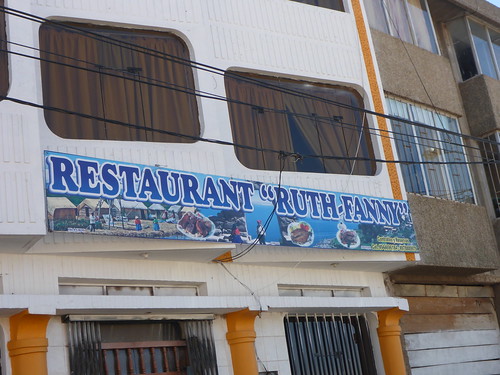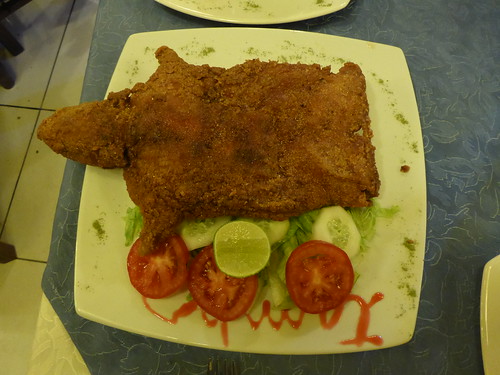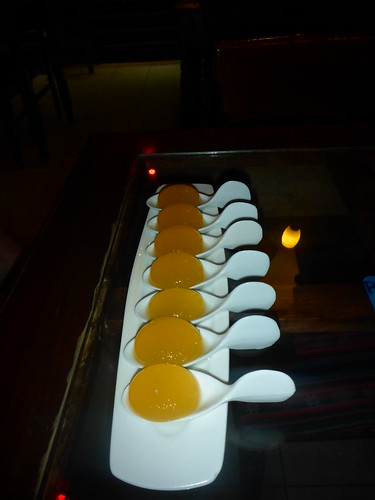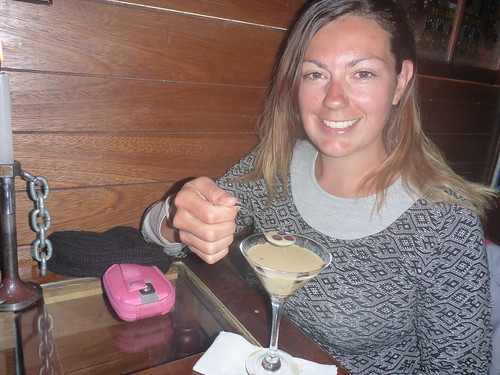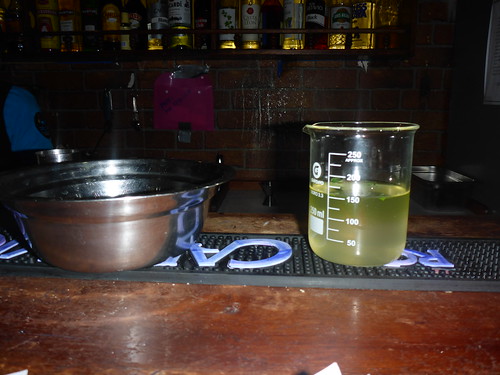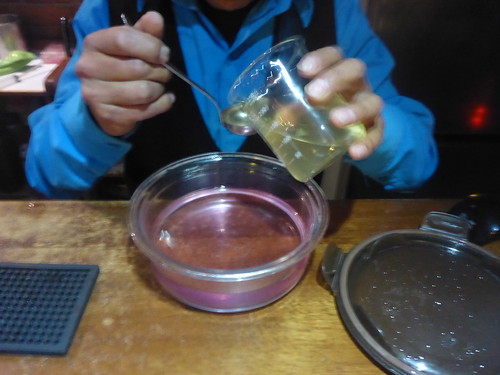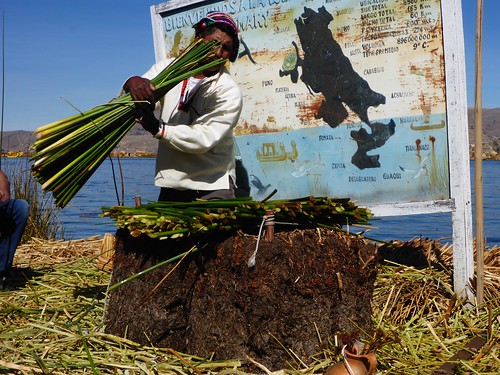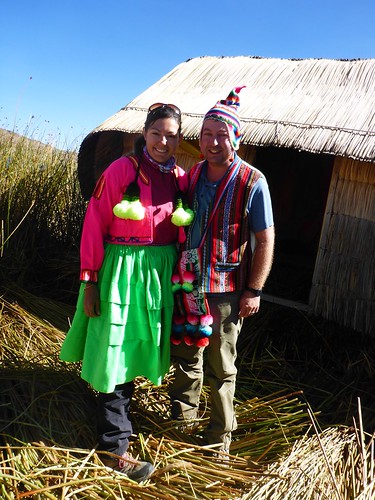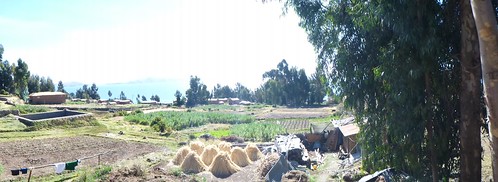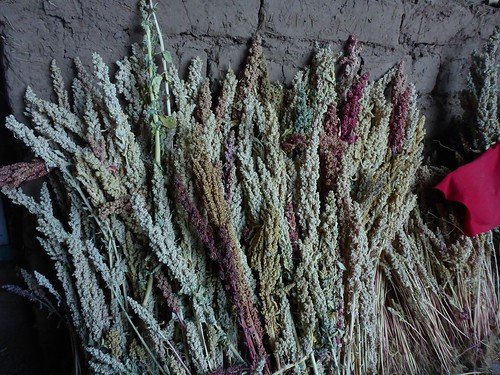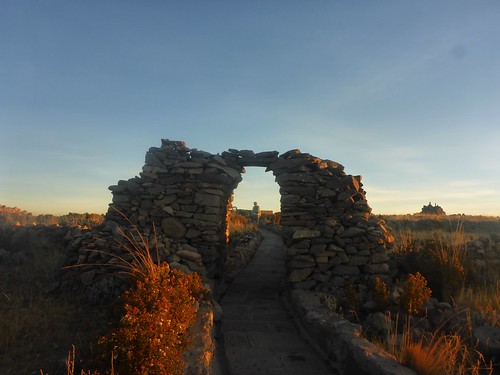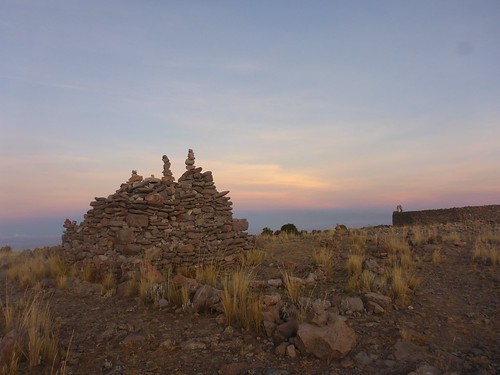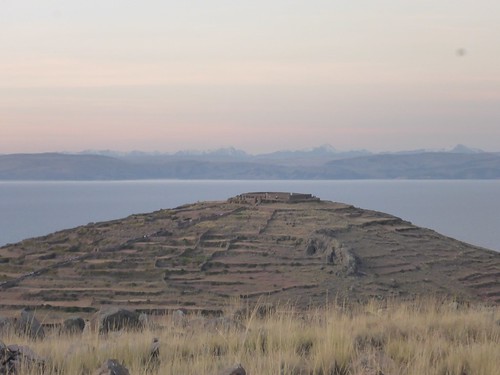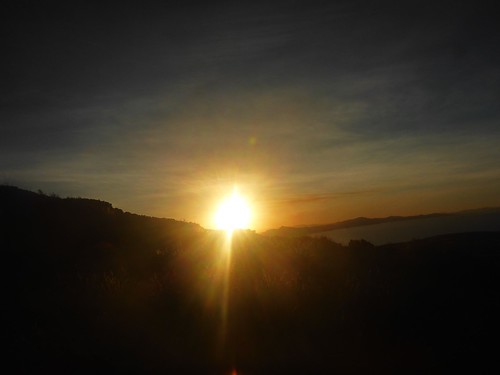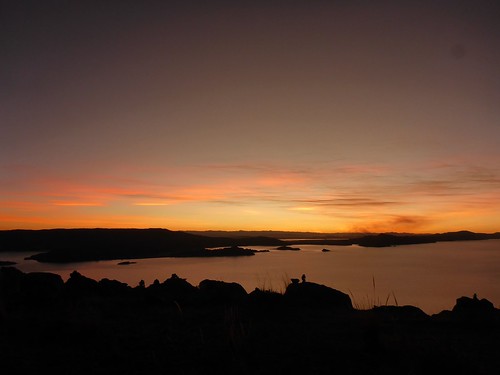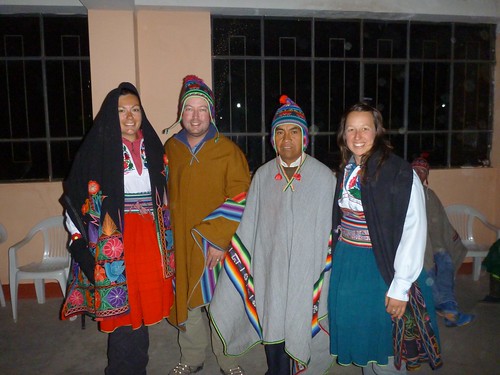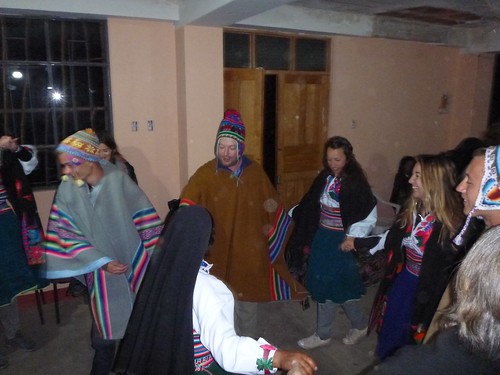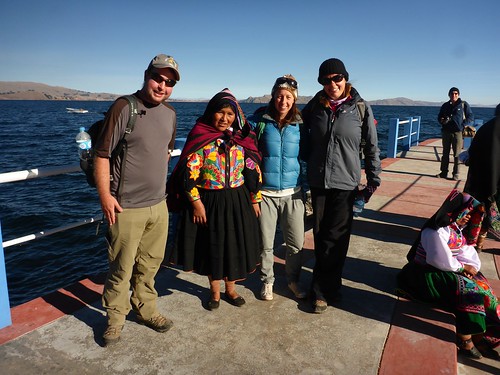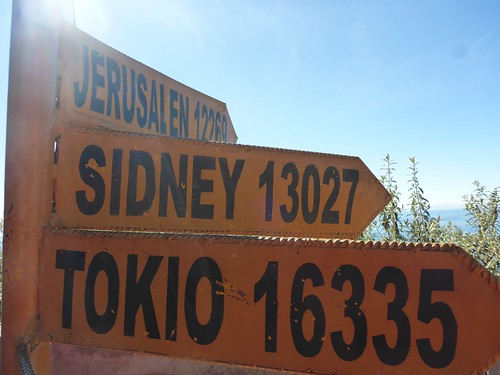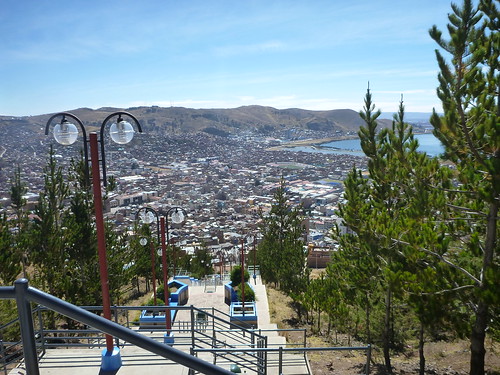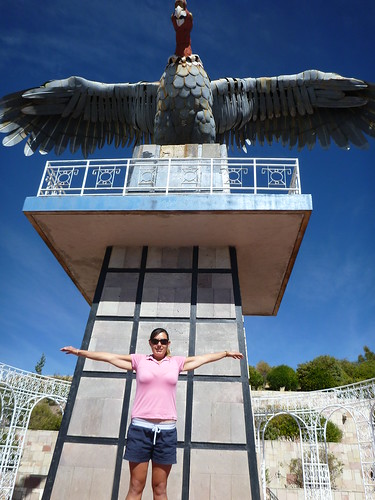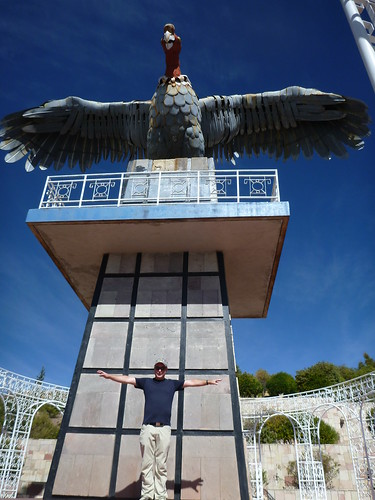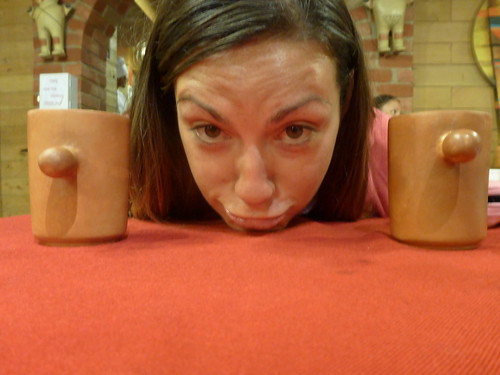Puno, Peru… the capital of the state, 3,830 metres above sea level, bordered by Lake Titicaca and an annual average temperature of 8.4 degrees Celsius.
Sleep deprived and braving the sunlight at 5am we were dragged off the bus for breakfast. Because it was so early, and not having much access to the bathroom for ten hours, we needed to wait on the side of the road until the restaurant opened. While waiting, we admired the local transport (tuk-tuks), and their creativity with the designs, and horns. There were flashing disco lights, various shades of paint and horns ranging from the air-in-a-can variety to something you would hear from a semi-trailer.
After sitting in the cold, for what seemed a lifetime, we were taken to ‘Ruth Fanny’, just around the corner for breakfast. It wasn’t until later in our stay in Puno that we’d realised the name of the restaurant and had a little giggle, sorry Ruthy (mum!). We’d had our favourite type of instant coffee, a plate of what could loosely be described as eggs, bread and jam, but needed to hurry back to the bus so it could depart to it’s next destination. Our bus had a large group of tourists who had booked part of the bus trip with the hop on/hop off company we were with, and another part of their trip with a different company… consequently we sat on the side of the road again, waiting for them to organise with our tour guide where they needed to go. While hurrying up, and waiting, we met Suze, another Aussie on the road and chatted about all the stuff we’d seen so far. We were then quickly shoved into a van and taken on a quick tour around to drop everyone off to their accommodation, and then to our hostel.
Dee literally walked into the door of the hostel, then waited for a bit until the doorbell was answered for us to check-in. Our room had it’s own private lounge room, complete with 1970’s décor, and our shower even had a shower curtain! After settling into our accommodation, and waiting until what was a more reasonable time to venture out, we headed down toward the main square of Puno to check out what this little city had to offer.
Like most cities in Peru, the early Europeans have very heavily influenced Puno; it was established in 1668 by the Spaniards and like many of the cities in South America the name of the city has been shortened. The city was originally called San Juan Bautista de Puno, and then later changed to San Carlos de Puno. Puno is the capital of it’s state and has a relatively small population to other cities we’ve been in with around 150 000 people. The economy relies primarily on black market goods smuggled in from Bolivia, as well as agriculture and livestock.
Heading toward the main square we were greeted with music and another explosion of colour… surprise, there was a parade happening. This particular parade was celebrating the farmers and agricultural unions of the area. Many of the locals were in very traditional dress, followed by uniformed band members, all marching around the small square which is towered by the city’s cathedral. Heading down the pedestrian mall we were accosted by people shoving menus at us, while others tried to sell us art pieces, key rings and knick-knacks made from reeds from the nearby floating islands… we’re sure quarantine would have a field day with those!
Looking around we settled on a place for dinner, deciding that Puno would be the place to have a try of guinea pig. For the South Americans, cuy, or guinea pig as we know it, is a delicacy and not a pet. The locals eat it at special events and festivals but many of the restaurants along the gringo trail in Peru have it on the menu for the tourists. The restaurant we had settled on had a large wood fired oven at the back of it, and a chef off the side making the pizza bases from scratch - we were quite surprised to see this, as pre-packaged food in some areas of Peru has been common. We tucked into the cuy and salad along with a few beers and were involuntarily entertained by a local band who we had to pay for at the end. The cuy was surprisingly delicious, it’s taste and texture similar to that of a rabbit… we’re sorry to anyone reading who has guinea pigs as pets, we promise when we’re home that we wont try to barbecue and eat them! (well Dee promises that).
After dinner we thought we’d check out a bar called Pacha Mixology across the pedestrian mall, intrigued by its signs suggesting they used nitrogen in their cocktails. Although the cocktails weren’t particularly cheap we decided that we needed to try them, starting with Ocho Orgasmos for Dee - eight spherical chocolate balls mixed in a glass of coffee liqueur, Bailey’s, whiskey, Amoretto and chocolate, topped with a liquid nitrogen. James decided that he was going to get the Mojitos Encapsulados, bubbles of the delicious cocktail, including the mint, served on spoons in perfect spheres that explode in your mouth.
The way this works is quite cool, and it’s been done a few times on MasterChef and My Kitchen Rules. There are two chemicals (safe to consume) which when mixed form a gel, and one is mixed into the cocktail. You put the other into a bowl, and carefully drop small amounts of the cocktail into the bowl - when the chemical comes into contact with the one in the bowl, it forms the gel. Because of the gel coating, the inside of the ball of cocktail doesn’t touch the chemical in the bowl, and stays liquid. You can carefully scoop them out and into the drink. Needless to say the experience at this bar was pretty cool, although their safety precautions probably defy every OH&S law in Australia.
The Peru Hop buses have a list of tours and optional activities that you can book, making it easier to avoid the onslaught of locals trying to sell tours off the shore of Titicaca. One of the optional tours included a trip our to the Uros floating islands, and an overnight homestay on Amantani Island. Early Friday morning we were picked up from our hostel and taken down to the jetty where we were shoved onto a boat with a bunch of other travellers, most of who couldn’t quite get themselves sorted out to sit on the boat in an orderly fashion.
Our first stop for the day was at Urus Islands, a collection of reed islands just off the shoreline of Puno. The reeds are taken from the shore, including the roots in the soil (they’re about a metre long), they are then tied together to make the base of the island. After that, the roots of more reeds are cut off, and the stems are stacked on top of the base; when completed the island is around two or three metres deep. Shelters and water towers are then built on top of the islands so that they can be lived on. Over time, they rot and sink a bit, so the residents need to keep cutting fresh reeds to put down on the “floor”.
Whilst on one of the more touristy islands we were given a demonstration of how the islands are built, and then had the locals try to convince us to buy all of their knick-knacks and handicrafts, most of which are made from reeds. We were dragged into one of the huts by the president’s wife, and made to dress up in some of the traditional attire. Instead of being elected as president, each male in the community takes turns, however a “mayor” governs all of the islands - we’re not quite sure what the election process is to become mayor. As well as making the islands, the locals make boats out of the reeds as well. The boats contain plastic water bottles to keep them afloat, and then the reeds are tied around the bottles to hold everything together, some of the boats are double storey and painted in bright colours to transport the tourists around, others are more practical and are used by the locals for fishing and transport between the islands.
After leaving the first island, we drove onto a second island where snacks and water were sold, then onto Amantani. Piling off the boat we were walked up the hill to a handful of ladies in traditional dress who were waiting to find out which of the gringos they were going to have living with them for the night. There are twelve communities on the island and each community takes it in turns to host homestays. Each family who opts to host the homestays have tourists stay with them once or twice a week within the month that their community has its turn. The homestays provide the community with a little extra money to survive, many of the men work on the mainland for months at a time, and then return to their home to see their family. The people on the islands don’t speak Spanish, Quechua or English as their first language, they speak Ayamara. We’d learnt some basic phrases before we’d left Puno (enough to say please, thank you and ask for the bathroom); however these phrases were much more difficult to remember than Spanish as none of the words are remotely similar.
Along the trip over we chatted to Suze, we realised on the boat that we may have been the only three people who spoke English. We weren’t sure how the group was being divided and allocated; after finding out that we had the option of pairs or threes we shot-gunned a home that could take three of us. Our host mum, Bacilia, took us up the hill, offering to carry our bags, on top of already carrying her child on her back. We, of course, carried our own bags and attempted to thank her in Ayamara but failed… we were very thankful to learn that Bacilia spoke Spanish. Bacilia guided us up the hill and around a few winding paths to her adobe (mud brick) house that her and her husband had built.
Not quite sure what to expect from the accommodation, we were greeted with very clean rooms that overlooked the lake from the second storey of the house. We settled in for an hour or so, taking photos and chatting until lunch was ready. Bacilia really knew how to cook! We were served up soup with quinoa, which they had grown themselves, and spaghetti with homemade tomato sauce. After lunch we were taken to the main square to meet with the rest of the group so that we could hike up the hill to two Incan sites. Following a slight misunderstanding and following the Bacilia’s father up the hill, Bacilia came chasing after us with her son swung across her back yelling to stop. After apologising profusely we kept walking to the square and were given a little bit of information about the island, the families, the culture and the walk we were embarking on.
Long walks at altitude are not always easy… we were told it was only an hour maximum to get up to the top of the hill, and then we’d be greeted by an amazing sunset. On the way up the hill we were offered many things to buy, including ceramics, llama key rings, drinks, horse rides and lollies. Resisting the temptation for a rest stop we eventually made it to the split in the path that lead to two mountain peaks: Pachamama (Mother Earth), and Pachatata (Father Earth) both of which have Incan and Tiwanaku ruins on the top. The side of the hills are terraced and are used for farming potatoes, quinoa and wheat. After making it to the top, aching legs and a little puffed, we walked around the ruins for a while and then settled in to watch the sunset, which was simply stunning.
After seeing Mother Nature in all her glory, we headed back toward town where Bacilia met us and took us back home for dinner. When we arrived back at her house we met Elias, our host dad, who sat with us and told us funny stories of other tourists they’d had stay with them. Including tourists expecting to have internet and full electricity, not being able to speak any Spanish at all (including basic greetings), expecting the host family to wait on them hand and foot and the general cultural misunderstandings that happen time to time when travelling. We also learnt that the two of them (like most of the locals) had built their own house from scratch, with help from friends. Thankfully, Elias and Bacilia seemed to like us and were very appreciative that we were able to talk with them.
As part of the home stay experience, the community holds a dance in the local hall, and all the tourists are given traditional clothes to wear. After getting dressed up, with help from Elias and Bacilia, we toddled off down the dark path in the cold with Elias leading the way, while Bacilia stayed at home to look after their child. After about 15 minutes walk we made it to the hall, without falling over once in the dark! We were shepherded into the middle to form small circles holding hands, and went around in circles until dizzy and then changed direction. After a while the small circles joined up into one big circle, which was harder to do but made us less dizzy. After being dragged around in circles and laughing at our ridiculous dancing we decided to call it a night. The walk back to the house was pitch black except for the torchlight, and some amazing views of the stars.
Saturday morning arrived and after a very decent night sleep we were summoned downstairs for breakfast. Bacilia is a really, really good cook - all of the food she has made us has been amazing and really tasty. The morning’s breakfast was no different with quinoa pancakes, jam and coffee.
After breakfast we headed down to the boat ramp, with Bacilia seeing us off. The next stop was Taquile Island, and a decent walk up the hill to the settlement. The town is another small rural one (around 2000 people on the island), however it houses a knitting and craft co-operative, that produces some of the best hand-crafted textiles in Peru. The products looked great, but we don’t have space to buy them for ourselves and shipping to send any back home is crazily expensive. There is a clear division of labour producing the items - the women do all the spinning and dying, and the men do the knitting (learning around 8 years old).
There were some quite nice views of the island and lake from the town, and even a sign telling us that it was a mere 13027km to Sydney! After about half an hour, it was time to go for a walk from the square to our lunch spot on the other side of the island. The walk was supposed to take an hour or so, but that’s obviously for slow people (and we had some with us) - the three of us made it there in less than 40 minutes. Lunch was the standard fare for the region, fried fish with rice and chips, but luckily had some delicious hot sauce to go with it. After the food, it was time to board the boat and head back to Puno.
Suze was leaving Puno that night, so we shared a few drinks and dinner with her. Dee had mentioned the crazy cocktails to her, so we headed there for a short time and then tried to find somewhere for dinner. We had recently enjoyed good pizza in the Andes and Suze felt like some, so we went to a nearby pizza place (in Pizza restaurant street obviously, there were about 10 close to each other). We had some delicious pizzas, although Suze’s had the quite interesting name of “Willy Pizza”.
Sunday morning was time to check out, so the early morning was spent packing our bags. We knew that there was a big condor statue up on the hill, we decided that there couldn’t be anything better to do at 3830m above sea level than walking up even more steps! There aren’t just a few steps to walk up, there are around 650 of them, but we did get quite a few nice photos of the city and lake from up the top.
The rest of the day was relatively quiet, we wandered around looking at a few thing we hadn’t seen yet, taking our photo of the local parliament and finally headed to a restaurant for dinner and their free music and dance show. Once it rolled around to 9:30pm, it was time to board the overnight bus to Arequipa.
Go see all the photos from Puno and Lake Titicaca
